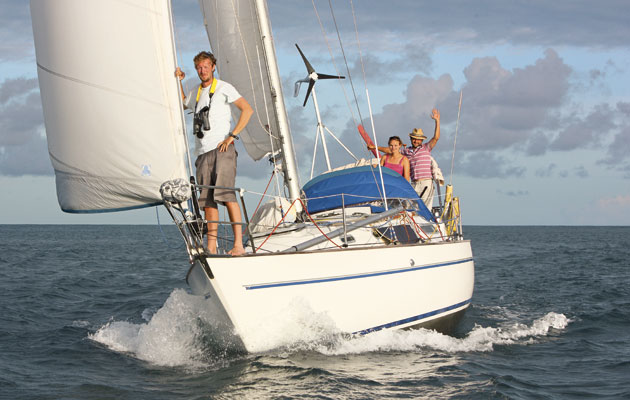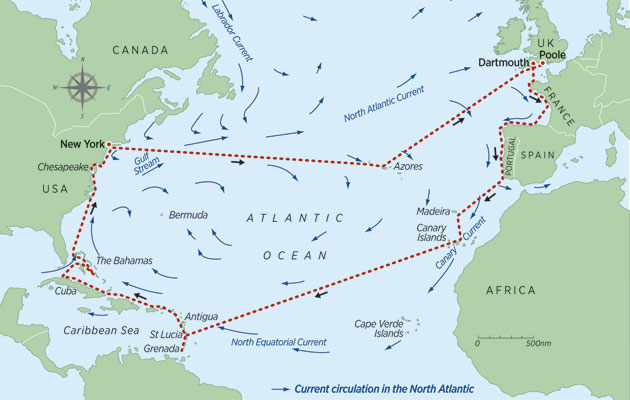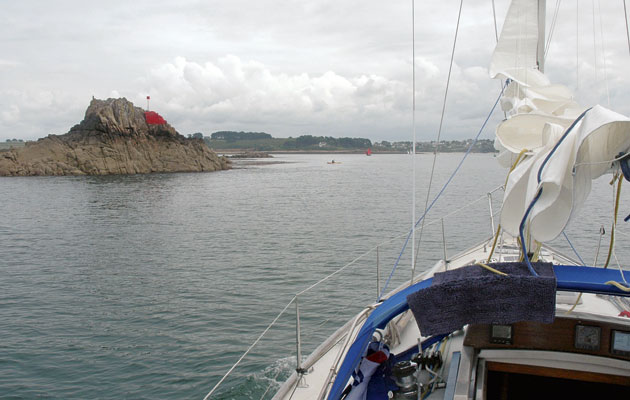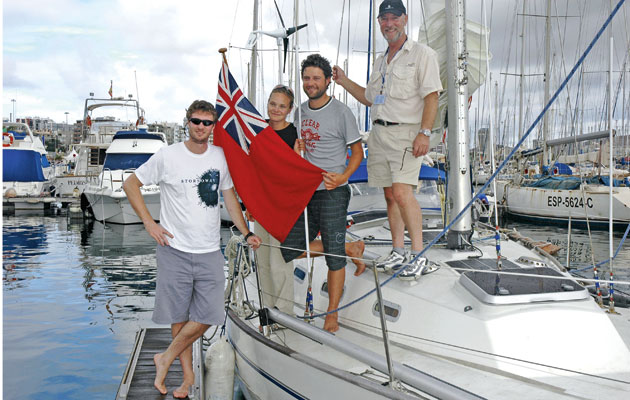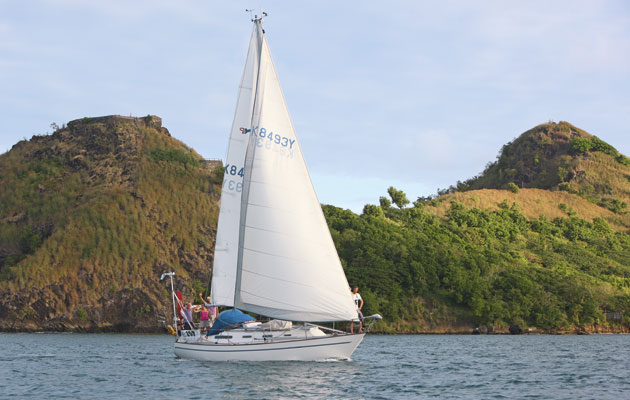Sam and Alexandra Fortescue share the knowledge and experience they gained on a one-year Atlantic circuit from the UK to the Caribbean, and back home via New York
How to sail an Atlantic circuit
‘There’s no turning back now,’ I said to my wife Alexandra as the auction closed. We’d put a cheeky bid in for a second-hand satellite phone in the dying seconds of an eBay auction and come away with the goods. Assuming the black box worked, we’d just saved ourselves £1,000 on the price of a new Iridium 9522, with antenna and cabling. More importantly, at £850, we’d made our first major purchase for the Atlantic crossing. New bulbs and lazyjacks could be seen as running costs, but this was the point where we both realised we had taken our first step on what would become a 12-month adventure aboard our Sadler 34, Summer Song.
The plan was simple. Alex and I would quit our jobs in July and make the most of a slow late summer cruise down to the Canaries where we’d join the Atlantic Rally for Cruisers (ARC), which was departing from Gran Canaria in mid-November for the 3,000-mile passage to the Caribbean. There would be Christmas with family in St Lucia, then months of leisurely cruising around the Windward and Leeward islands, before returning home via the East Coast of the USA and the Azores.
But the boat needed some minor surgery and plenty of kitting out. Having sailed her for years we had a lot of ideas on how we could improve her, but we also turned to the internet and ARC organisers World Cruising Club for important details on kit.
The ARC is a serious undertaking, and the organisers put safety before all else. Consequently, there is an exhaustive list detailing types of flare, the required strength of emergency torches and the precise equipment you need to attach to your unloved yellow horseshoe buoy (drogue, whistle, reflective tape and light).
After much discussion and research, we went for a straightforward downwind rig using twin headsails. We bought a Seldén whisker pole to mirror our existing spinnaker boom, so we could pole out two genoas. Our sail locker included a 150% genoa, a 100% genoa, 70% No3 headsail and tri-radial spinnaker.
We also found an ISAF safety course quite handy. Who would have thought that it was worth packing safety pins in the grab bag to fish from the liferaft? A medical friend provided a bit of invaluable advice, saying there isn’t much that can’t be treated with clingfilm, superglue and painkillers. We made sure we carried spares for almost every piece of equipment on board – doubly so for crucial items such as filters, pumps, drive belts and so on.
In July we duly quit our jobs and moved out of our flat. Then, on a damp and dreary August morning, we puttered out of Baltic Wharf in Totnes. It was hard to believe that we were setting off for the Caribbean.
Brittany and Biscay
Disaster struck before we had sailed two miles down the River Dart. A great tide of dark water began to slop over the top of the locker under the saloon berth. I’d forgotten to tighten the filter housing in the water maker intake, allowing seawater to trickle into a year’s supply of teabags, creating 300 litres of cold, salty Earl Grey.
Hugging the Brittany coast, we made short hops between the stunning, rocky islands of Groix, Belle-Ile and Houat. Then it was on to the bigger islands of Noirmoutier, Yeu and Ré, whose wild Fier d’Ars estuary and citadel port of St Martin took our breath away.
It was already mid-September and most of the pilots suggested that we should by now be in Portugal, to avoid the onset of autumn gales. So we sailed back under the majestic Ré Bridge as the sun sparkled on a calm sea and the wind blew steadily from the north-west. We fetched the lights of Santander at 0400 on the second day.
North Spain has a reputation as a desolate, difficult cruising ground – even the Royal Cruising Club said so – and we soon understood why.
The many rivers that provide shelter in summer are in spate in the autumn. Strong currents make harbours difficult to enter. We touched the bottom in one anchorage, dragged in another, and then spent 10 days hunkered down in Viveiro on Spain’s northwest tip waiting out a series of depressions and pounding swell.
We were both glad when a clear day dawned and we were at last able to round Cabo Ortegal and Finisterre in quick succession. Southern Galicia offered some delightful anchorages including eucalyptus-fringed Cedeira, Muros, the Arosa estuary and Islas Cies, all as close to a Caribbean idyll as you can get in Europe. We skipped down the Portuguese coast in a series of daysails, falling into step with other yachts planning to overwinter in the Med or make an Atlantic crossing.
Our first serious test came when we left mainland Europe on the 500-mile passage to Porto Santo in the Madeira group. Each day brought different conditions, from flat calm at the start to a pounding, shuddering beat through malevolent waves as squall after squall raked us. We used the deep third reef in the main for the first time, and spent two days dripping with a mixture of rain and spray before we spied a volcanic peak just after dawn on day five and knew our ordeal was over.
Preparing for the ARC
Our in stay in Madeira was short. We wanted to get to Gran Canaria in plenty of time to enjoy the build-up to the ARC. Besides a series of excellent seminars, there was also the small matter of repairs and provisioning. We felt an extraordinary sense of achievement after three months of sailing and some 2,000 miles on the log, but we’d only reached the start line.
We were joined for the crossing by my brother-in-law, Will, and his uncle, Graham. The two weeks of preparations went by in a flash. As we passed cheering crowds on our way to the start line, excitement replaced the nervousness I always feel before a long passage, and we were soon relaxing and enjoying the sun and good northerlies.
Non-sailors always wonder how we dealt with 25 days at sea. But in truth, we were reluctant to make landfall when we eventually reached St Lucia on 16 December. For a few days, we felt we understood the motivation of Frenchman Bernard Moitessier, who abandoned the Sunday Times Golden Globe Race in 1969 in order to remain at sea. The bond we built up during the long days and nights at sea meant that our small 34-foot world was our only reality. We fished, swam in glassy waters 4,000m deep, faced strong winds and high seas, and even had to send a man up the mast to retrieve the spinnaker halyard. It was an experience like no other, and sharing it has bound the four us together tightly.
Despite a hero’s welcome in Rodney Bay for the ARC boats, we felt impatient to begin our Caribbean adventure, and left after the closing ceremony for the 120-mile reach down to Grenada. We spent Christmas in the refined surroundings of Prickly Bay on the crinkly south coast, which is pitted with intriguing bays and peaceful mangroves. Then we turned north to run up the entire island chain, starting with the Grenadines.
These are like pearls amongst the swell of the Atlantic, and people come here from all over the world for the warm turquoise waters and the gentle pace of the Caribbean. We loved Tyrell Bay on Carriacou, a real yachtsman’s anchorage, and the endless booming of the waves on the coral reefs around Tobago Cays.
We were lucky to find anchoring room in Mayreau, where charter boats and beamy catamarans are so thick in the water that you can practically cross the bay without getting your feet wet. On St Vincent’s west coast, we enjoyed a stunningly peaceful night and great snorkelling at anchor in little-known Petit Byahaut, a small and eerie bay where thatched huts lie abandoned in amongst the rainforest.
Underestimating both wind and seas, we had a lively passage up to Martinique and the large natural harbour of Le Marin. There is a supermarket on the waterfront with its own dinghy dock, which allowed us to unload mountains of subsidised French cheese, yoghurt and wine directly into our tender. And the bay is a good base from which to explore Martinique’s lush rainforest and extraordinary rounded mountains.
There are many well-trammelled anchorages up the island’s leeward coast, but we forsook them for the delights of its coral-bound east coast. The area is peppered with off-lying islands, bays and hurricane holes which reward careful navigation. The coast does not figure in some of the pilot guides and is off limits to most charter boats – all the ingredients for a splendid cruising ground!
We considered skipping Dominica, the next island to the north, but as soon as we raised its dramatic cliffs and rainforest-clad peaks, we changed our minds.
The island is steep-to, but there are moorings near the capital Roseau, and decent holding in Portsmouth Bay to the north. Volcanic activity includes a boiling lake, hot springs and a champagne reef, which fizzes gently with steam escaping from cracks in the seafloor.
After a Cruising Association meet in Pointe-a-Pitre, Guadaloupe, we made for the Jacques Cousteau marine reserve. In a region where clear water and abundant fish are taken for granted, the reserve is a sensational spectacle with outstanding diving and snorkelling.
Then it was forty miles to Antigua, where we anchored in the dramatic surroundings of Nelson’s Dockyard, where the young Captain was on station in the 1780s. Nearby English Harbour hosts dream boats and sailors from every corner of the world.
My parents joined us and we shoved off for a circumnavigation of the island, via the treacherous but beautiful east coast. Coral is abundant around Antigua, but the navigation is relatively simple.
The two key cruising grounds are Nonsuch Bay and North Sound, complete with desert islands, long beaches and turquoise waters. Long tailed tropical birds wheeled and squawked overhead, while the shallow seas heaved with turtles, fish and magnificent coral gardens.
In our bid to leave no island unexplored, we continued to Montserrat – an island decimated in 1995 by its still-smoking volcano. Although it has never recovered from losing its capital to mud and ash, the island has a jaunty and relaxed air to it. Those who remain seem determined to enjoy themselves. However, there are only two viable anchorages, and they are both subject to tremendous swell. Luckily, we were able to spend several nights ashore with friends.
After some low-cost reprovisioning in St Maarten, we raced on to the British Virgin Islands for the Spring Regatta with friends and family before heading onto Cuba.
Armed only with Nigel Calder’s evocative but 12-year-old cruising guide, we were unsure what to expect from Cuba. Just getting there was a mission in itself – two-up through 1,000 miles of deep blue seas.
We had planned to clear into the country at Cayo Coco Guillermo, one of the few ‘international’ marinas on the north coast able to process foreign vessels. But after heaving-to for the night, we were unceremoniously redirected 160 miles further west towards the tourist peninsular of Varadero.
We arrived at Varadero tired and frustrated. There was a three-hour wait for a doctor, whose token examination consisted of asking: ‘Do you feel unwell?’ Then, a small army of officials swarmed aboard – customs, police, a sniffer dog and her handler, a vet, a representative from the agriculture ministry, and the harbourmaster. Despite the length of the process, people were very friendly and by mid-afternoon we were cleared in.
Varadero itself is a package tourists’ town and we used it as a base, but it still boasts an astonishingly beautiful beach. For exploring by boat, many old rules restricting access to bays and ports have now been lifted, but the waters are often shallow and poorly charted.
Cuba is well within the hurricane belt, and we wanted to be heading north before the end of May. With three weeks to spare, we hitched a ride towards the Bahamas on the Gulf Stream. At about the latitude of Miami, we turned east across the Great Bahamas Bank. For two mirror-calm nights in a row, we simply dropped the hook on the shallow bank for a motionless night – completely out of sight of land. It was totally unique and utterly outside our previous sailing experience.
Heading north for New York
In fact, the Bahamas were an unexpected pleasure. I had imagined there would be extensive US-style development, but even its capital, Nassau, had a sleepy Caribbean feel to it. Thirty miles away over the coral-strewn Yellow Bank, the Exumas provided a dreamy 10 days of exploring. Their reputation for difficult pilotage was overblown. Instead there were empty coves and beaches, great snorkelling in clear turquoise water, and plentiful fish.
With heavy hearts we set sail on a 900-mile voyage to Chesapeake Bay in late May, leavened only by the last minute recruitment of our old shipmate Graham. Despite the presence of the Atlantic fleet in Norfolk, Virginia, it took just 15 minutes to clear customs. Chesapeake is a huge and varied cruising ground, but it was now June, and we zigzagged quickly up the 120-mile long bay towards Chesapeake and Delaware Canal, an inland shortcut on the passage to New York. The highlight was anchoring in the centre of beautiful Annapolis.
Later, Manhattan’s skyline took our breath away as we swooped by the Statue of Liberty, sailing close to its skyscrapers and under the Brooklyn Bridge. After a short passage up the East River, we motored to nearby Port Washington, where visiting yachts can spend two free nights on the town moorings. With time running short, we made for Cape Cod and sailed through fog to Martha’s Vineyard, where American presidents take their summer holidays.
At the skipper’s insistence we pressed on through the fog to visit the legendary whaling community of Nantucket, Massachusetts, before backtracking to the yachting mecca of Newport.
Homewards via the Azores
Preparations for our return crossing were much quicker than they had been in Gran Canaria. The boat was in good shape and we had a clearer idea of the demands of an ocean passage. With extra crew, Chris and Elise, it took just two days to provision, refuel, and get everything shipshape. We spent our last night in the expensive but lovely Newport Shipyard, then set sail into 18 knots from the southwest.
We soon settled into the 24-hour rhythm of a long passage and followed the 39th parallel to stay clear of ice and shipping. Conditions remained benign despite some strong winds and towering swell.
After just 15 days, we reached Flores, the westernmost of the Azores group, and an island festooned with blue hydrangeas. It’s often said that Caribbean cruisers find the Azores to be one of the most pleasant locations, and so it was with us.
But at this late stage of the trip, the urge to finish passage-making and hang up our wet weather gear was strong. I was also anxious about passing into the band of depressions that march across the North Atlantic, so we were glad to slip our berth on 8 August. We made landfall at the Lizard by dusk on the eleventh day after nothing more worrying than a calamitous drop in temperature and some heavy rain.
As we rounded Anvil Point and bore away towards Old Harry, the Needles gleamed to the east and we were transfixed by the beauty of Dorset’s Jurassic Coast. We then slid past the Sandbanks chain ferry on the last of the flood and made our way through a busy Poole Harbour to moor up at the Town Quay.
The English rain couldn’t dampen the joy we felt at seeing our families again, who were lined up along the quay, dripping wet, and we quickly moved onto a pub for that long dreamed-of pint of ale.
It would be a stern constitution that didn’t yearn once again for the warm winds and clear waters of the tropics, and –although I’m not really allowed to say it just yet – I’m certain that this will be the first of many blue water cruises aboard Summer Song.
Enjoyed reading this?
A subscription to Yachting Monthly magazine costs around 40% less than the cover price.
Print and digital editions are available through Magazines Direct – where you can also find the latest deals.
YM is packed with information to help you get the most from your time on the water.
- Take your seamanship to the next level with tips, advice and skills from our experts
- Impartial in-depth reviews of the latest yachts and equipment
- Cruising guides to help you reach those dream destinations
Follow us on Facebook, Twitter and Instagram.




